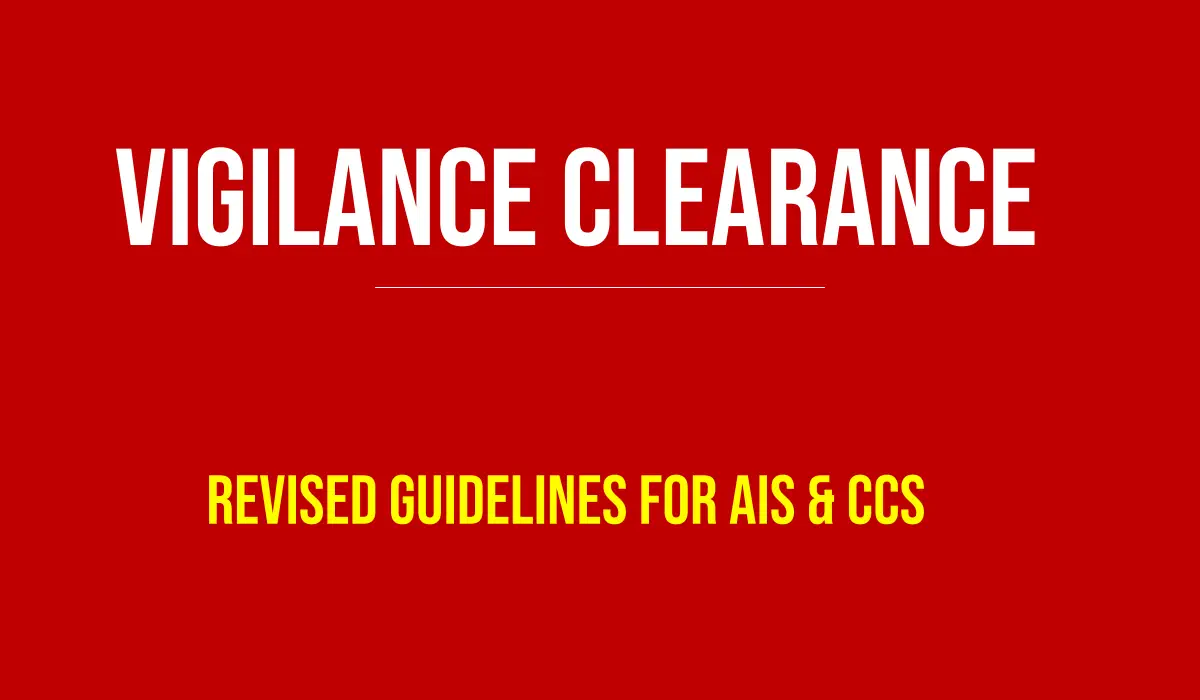Revised Vigilance Clearance Guidelines Issued by DoPT for AIS Officers and Central Civil Services

In an effort to streamline procedures and improve transparency, the Department of Personnel and Training (DoPT), Ministry of Personnel, Public Grievances, and Pensions, has issued revised guidelines for granting vigilance clearance to All India Services (AIS) officers and members of Central Civil Services/Central Civil posts. The updated guidelines, outlined in an Office Memorandum (OM) dated October 9, 2024, aim to provide better clarity for officials and stakeholders.
The vigilance clearance process is critical for government employees, particularly in appointments, promotions, and transfers. These revised guidelines provide a detailed framework under which vigilance clearance can be granted or denied.
Key Situations Requiring Vigilance Clearance
The guidelines specify that vigilance clearance is required in several situations, including:
- Inclusion in the Offer List: Officers being considered for inclusion in selection lists must first obtain vigilance clearance.
- Empanelment: Officers seeking empanelment at various levels need clearance to ensure there are no pending issues that could impede their eligibility.
- Study Leave (Ex-India): Officers planning to go abroad for study purposes will need clearance.
- Inter-Cadre Transfers and Deputation: The guidelines also cover vigilance requirements for inter-cadre transfers, deputations, and any extensions thereof.
- Appointments to Sensitive Posts: Ensuring that officers holding sensitive positions are free from vigilance concerns is paramount.
- Training Programs: While mandatory training is exempt, vigilance clearance is necessary for officers taking up other training assignments.
- Retirement, Commercial Employment, and Repatriation: Clearance is also required for voluntary retirement schemes (VRS), post-retirement commercial employment, and premature repatriation.
Grounds for Denial of Vigilance Clearance
The revised guidelines provide a clear list of grounds on which vigilance clearance may be denied:
- Pending Complaints or Preliminary Inquiries: If a complaint has been received against an officer, and it has been established through a preliminary inquiry that there are verifiable allegations involving vigilance issues, clearance may be denied. Allegations may include corruption, misuse of influence, misappropriation, moral turpitude, or violations of the All India Services (AIS) Conduct Rules, 1968.
- Suspension or Disciplinary Proceedings: Officers who are currently under suspension or facing disciplinary proceedings will be denied clearance until their cases are resolved.
- Pending FIR or Court Chargesheet: In instances where an FIR has been filed, or a chargesheet has been submitted in a court of law, vigilance clearance will be withheld.
- Non-submission of Annual Immovable Property Return (IPR): Officers who fail to submit their annual Immovable Property Return by January 31st of the current year, as required under Rule 16 of the AIS Conduct Rules, 1968, may face denial of clearance.
- Minor or Major Penalties: If a minor penalty has been imposed, clearance will be denied for three years after the currency of the penalty. For major penalties, the denial period extends to five years, and continued monitoring may be required.
Case-by-Case Assessment by Competent Authority
In certain cases, vigilance clearance will be decided on a case-by-case basis, keeping in view the sensitivity of the purpose, the gravity of allegations, and the facts and circumstances. Such cases may include:
- Prolonged Investigation: Where a pre-investigation enquiry remains pending for more than three months.
- Non-Completion of Investigation: Where investigating agencies fail to complete investigations within two years, the officer may still be considered for non-sensitive posts, but clearance will not be granted for other appointments.
- Court Restrictions on Case Closure: Where courts do not permit the closure of a case or FIR despite recommendations from investigating agencies.
Special Instructions for Empanelment
The guidelines also include specific instructions for granting vigilance clearance for empanelment. In such cases, the vigilance status of officers will continue to be ascertained from the respective Cadre Authority, and comments from the Central Vigilance Commission (CVC) will also be obtained.
Approval Process for Vigilance Clearance
The authority to issue vigilance clearance depends on the level of the officer:
- For officers up to the level of Deputy Secretary/Director in a Ministry or Department, the Head of Vigilance Division grants clearance.
- For higher-level officers such as Joint Secretary, Additional Secretary, or Secretary, clearance is granted with the approval of the Secretary of the Ministry/Department.
These guidelines provide clarity and aim to bring consistency in the decision-making process regarding vigilance clearance, ensuring accountability and transparency across government services.
Full official OM given below:
 Loading…
Loading…




